|
|
Fake Railroad Locks
Fake locks are becoming quite a problem in the railroadiana
hobby. For the most part, the problem centers on "castback" locks
-- older, brass locks in which an ornate railroad name or logo is cast into the
back of the lock. Genuine castback locks are the premier locks in the
hobby and command high prices, so it is not surprising that counterfeits
have been made. Steel railroad locks were made later and are much plainer
in appearance. These generally go for much less money and therefore are
not worth counterfeiting.
Following are fake locks that we have been informed about.
| Right. Shown are two views of a fake Northern Central Railway cast brass lock that surfaced in 2009. It has the same keyhole and cover as the C&S Ry lock shown below. Click on any image for a larger version. |
 |
 |
 |
 |
 |
 |
Above. This fake Colorado & Southern Railway cast brass lock surfaced in 2007. Click on any image for a larger version. A few comments about it:
"I was totally fooled by the face but I did notice a couple of differences that I was willing to go along with as possibly manufacturing variations. One was that there’s an extra period under the “AND” and before the “S” that isn’t on the original. The second is that the originals of this version of the C&S fancy lock without the pebbled background are not a full size switch lock and are slightly different shaped; they are smaller than the C&S fancy that has the pebbled background. This one is the same size and shape as the pebbled background version. But I sort of discounted it as a possible variation in manufacturing. The front gives it away totally.
Notice the complete lack of wear and patina."
This is the first C&S fake I’ve seen or heard of. One thing is for sure. Whoever is doing this is being supplied with original locks to make copies of. And not all the ones that have shown up as fakes have been for sale on the web, so someone with an advanced lock collection has either sold or is supplying these for reproduction."
This the same style as the fake C RR of NJ, NYS & W, N & W and other locks that were offered on Ebay about a year ago by the same dealer. It was indicated in the article that the faker must have had access to an original C & S lock to make the copy. However, as a former owner of an authentic C RR of NJ, I can state for a fact that I know of only 2 in existance, and, the fakers DID NOT have access to an original. Unfortunately, I believe that who ever is reproducing them can do it from a photo alone, as the fake CNJ didn't appear until a photo of my lock was posted on the internet. That would also indicate why there are little "differences" found on the fake locks that aren't shown on the originals. If they did have an original lock to make a casting from, I believe it would look exactly the same, without variation Also one of the main characteristics for identifying one of these fakes is the "tab" on the side of the dust cover and keyhole. -DA |
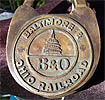 |

|
 |
| Above. This Baltimore & Ohio Railroad cast brass lock is a fake and surfaced in 2007. The key that came with it is similar to other keys that have accompanied recent fake locks. Notice the complete lack of wear and patina. Click on any image for a larger version. |
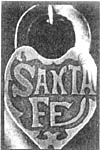 |
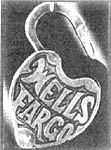 |
 |
| The Santa Fe, Wells Fargo, and UP RY privy locks, above,
are counterfeit and never existed as genuine locks in this design.
Two other counterfeits are marked D&RG RR, below left,
and Santa Fe System. These are copies of authentic locks. The manufacturer
listed on these locks is JHW Climax. For comparison, a genuine D&RG
RR lock made by Slaymaker is shown, below right. |
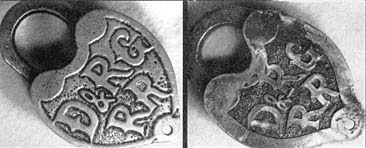 |
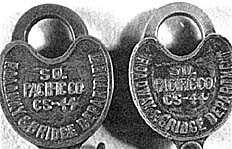 |
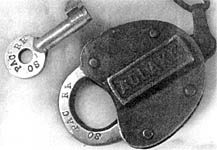 |
| Fake locks like the one shown above
right have been made in Taiwan. They are cast "SO. PACIFIC
CO. CS-44 ROADWAY & BRIDGE DEPARTMENT" and have Adlake
marked on the key cover as does the genuine version. Shown above
left is a genuine example for comparison. Note that the original
is slightly bigger. |
Shown above is a stamped but fake
Southern Pacific lock. Someone took a genuine Adlake brass lock and
stamped "SO PAC RR" on the hasp. Most genuine SP locks
are stamped "SO PACIFIC CO" rather than "SO PAC RR." The
same applies to keys. |
| Shown at immediate right is
a fake, brass lock, again imported, that is marked for "M.C.R.R." There
is another one like this marked "G.W.R.R." Shown at far
right is a fake brass lock marked "UNION PACIFIC CS-21 ROADWAY & BRIDGE
DEPARTMENT". There are in fact genuine locks like this, much
like the Southern Pacific fake and genuine versions shown above. |
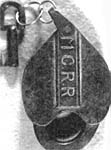 |
 |
| At right, large
Central & Union Pacific locks such as this example were made
for a collector by an iron monger in Missouri about 20 years ago.
He also had the same type lock made with "Winchester", "Wells
Fargo" and "Pauly Jail Co." names on them. The shape
of this lock is unlike any qenuine railroad lock, and it is much
larger than genuine railroad locks also. There never was a railroad
called the "Central Union & Pacific Railroad". The
name is obviously an amalgam of actual railroad names. |
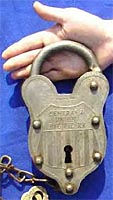 |
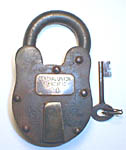 |
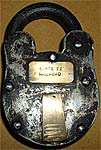 |
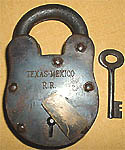 |
 Shown above
left is a brass lock with an attached tag marked "CENTRAL
UNION & PACIFIC" -- a fictitious railroad. A closeup of
the tag is shown upper right. There are reports of other
versions with fictitious railroad markings such as "Southern
Rio Grande Pacific" as well as markings from real railroads
such as the Santa Fe example shown above middle.
A variation without the brass tag is the "Texas-Mexico RR" version
shown above right . At right is a SOUTHERN
PACIFIC LINES "Sunset Logo" fake, brass lock. Note the
rather crude casting, new color of the metal, and the complete
lack of wear. Shown above
left is a brass lock with an attached tag marked "CENTRAL
UNION & PACIFIC" -- a fictitious railroad. A closeup of
the tag is shown upper right. There are reports of other
versions with fictitious railroad markings such as "Southern
Rio Grande Pacific" as well as markings from real railroads
such as the Santa Fe example shown above middle.
A variation without the brass tag is the "Texas-Mexico RR" version
shown above right . At right is a SOUTHERN
PACIFIC LINES "Sunset Logo" fake, brass lock. Note the
rather crude casting, new color of the metal, and the complete
lack of wear. |
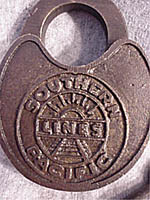 |
 Fake"Castback" locks.
Collectors have reported various fake,
cast brass locks that have surfaced. Recent versions include Norfolk & Western
(authentic version shown at upper right), Central Railroad of New
Jersey (authentic version shown lower right),
New York, Susquehanna & Wester, and PRR.
The quality of the lock casting is poor and there are vertical striations in the brass. Similar and authentic
PRR locks are shown on our locks page. Fake"Castback" locks.
Collectors have reported various fake,
cast brass locks that have surfaced. Recent versions include Norfolk & Western
(authentic version shown at upper right), Central Railroad of New
Jersey (authentic version shown lower right),
New York, Susquehanna & Wester, and PRR.
The quality of the lock casting is poor and there are vertical striations in the brass. Similar and authentic
PRR locks are shown on our locks page.
We recently received the following comment, "In addition to the
variations from a real lock that your website mentions, the key also
varies in that the shank appears as two sections, with varying widths.
Also, while the lock does have a spring loaded dust cover, the locking
mechanism doesn't have any springs. You turn the key to the right
to unlock the lock (which doesn't spring open). To lock the lock,
you have to push the hasp back into place, then turn the key to the
left." (Thanks to Jeff P.) |
 There
has been a recent report of a fake NYC (New York Central) Yale signal
lock. The fake is distinguished by being oversized and having rather
poorly cast letters. An example of an authentic Yale signal lock from
the Wabash Railroad can be found on the Railroadiana
Online locks page. There
has been a recent report of a fake NYC (New York Central) Yale signal
lock. The fake is distinguished by being oversized and having rather
poorly cast letters. An example of an authentic Yale signal lock from
the Wabash Railroad can be found on the Railroadiana
Online locks page.
See the following website that discusses reproduction
locks, including the Wells Fargo reproductions and a new page on fake
Santa Fe "Keen Kutter" locks.
Comments
or additional information are welcome. See Contact Us page.
Special thanks to Bill and Sue Knous for permission to
reproduce text and images from their book on railroad counterfeits. Also thanks to Tom Stranko, Eric Miller, Gary Farmer, Rick Kominsky and other collectors who have sent in images and information. |